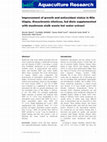Papers by Shaharudin Abdul Razak

Indian Journal of Fisheries
The study examined the effect of partial replacement of fishmeal with Spirulina platensis (SP) an... more The study examined the effect of partial replacement of fishmeal with Spirulina platensis (SP) and Chlorella vulgaris (CL) powder in the diets of African catfish Clarias gariepinus (Burchell 1822) fingerlings on growth performance and body composition. Nine diets (45.14-48.45% crude protein) consisting SP or CL as fishmeal replacement at zero (control), 12.5, 25, 50 and 75%, were fed to triplicate groups of 10 fingerlings (7.82±0.08 g) each for 56 days. The results showed statistically higher weight gain, specific growth rate, protein efficiency ratio, relative growth rate, Fulton’s condition factor (K) and a corresponding lower feed conversion ratio when the replacement of C. vulgaris was at 75%. Proximate analysis revealed a significantly greater carcass protein in the SP12.5% and the highest flesh lipid and gross energy in SP75% groups. Flesh lipid increased with increasing SP and CL levels. Polynomial curve estimation regression analysis revealed the optimum fishmeal replacement...
Iranian Journal of Fisheries Sciences, Jul 10, 2007

This study investigated the effects of Spirulina platensis and Chlorella vulgaris on the growth, ... more This study investigated the effects of Spirulina platensis and Chlorella vulgaris on the growth, non-specific immunity and survival of Clarias gariepinus. C. gariepinus juveniles were infected with Aeromonas hydrophila after a 16-week feeding period with 5 different diets which served as replacements for fishmeal diet. The diets are 50% C. vulgaris (CL50%), 75% C. vulgaris (CL75%), 50% S. platensis (SP50%), 75% S. platensis (SP75%), and control (100% fishmeal). Fish (n=225; 41.85± 0.05 g) were randomly divided into fifteen tanks (150 L capacity each) with triplicate groups of 15 fish per tank. CL50% had the most significant (P 0.05) in growth performance among the algae treatments. Similarly, lysozyme and respiratory burst activity and post-challenge haemoglobin, haematocrit, red blood cells, serum total protein, albumin and higher density lipoprotein cholesterol were significantly higher (P<0.05) in CL50% treatment. The present study indicates that replacing 50%-75% of fishmeal ...
A study of the major Arthropoda taxa of invertebrates recolonizing Saraca roots occurring on vari... more A study of the major Arthropoda taxa of invertebrates recolonizing Saraca roots occurring on various substrates and under various water velocities was carried out in the upper reaches of the Gombak River. The sites for the recolonization experiments were selected in the fast and slow flowing sections of rocks and boulders, sand and gravel and mud and silt biotopes. The Hydropsychidae and the Nemouridae were the pioneer recolonizers of Saraea roots in the fast flowing sections of the stream whereas the Ptilodactylidae and the Caenidae were the pioneer recolonizers in the slow flowing sections of the stream.

Journal of Fisheries, 2018
In our present study, we observed the effect of cricket meal (CM) on disease resistance of Africa... more In our present study, we observed the effect of cricket meal (CM) on disease resistance of African catfish. Fish were fed diets containing 350 g kg–1 and 400 g kg–1 of CM and 350 g kg–1 of fishmeal as control. The fish were divided into triplicates treatments of ten fish per replicate, weighed 22.5±0.6 g and fed with experimental diets for 40 days before being challenged against Aeromonas hydrophila. Relative percentage of survival (RPS) was recorded over 12 days post-challenge. White blood cell count, total protein, globulin and lysozyme showed significantly increasing levels in those fed with cricket meal diet compared to the control group. Mortalities at 12-day post-challenge significantly decreased to 30% (RPS: 66.7%) and 27% (RPS: 70%) for 35% and 40% CM respectively compared to 90% mortality in control group. Intestines and liver tissues of infected fish were dissected for pathogenic confirmation. The intestines of control diet showed the highest bacterial load (58.2×107 cfu g...

Research in veterinary science, Jan 25, 2018
This study explored fishmeal replacement with two freshwater microalgae: Spirulina Platensis and ... more This study explored fishmeal replacement with two freshwater microalgae: Spirulina Platensis and Chlorella vulgaris in African catfish (Clarias gariepinus) diet. The effect of inclusion of the two microalgae on biomarkers of oxidative stress, haematological parameters, enzyme activities and growth performance were investigated. The juvenile fish were given 3 distinct treatments with isonitrogenous (35.01-36.57%) and isoenergetic (417.24-422.27 Kcal 100 g1) diets containing 50% S. platensis (50SP), 75% S. platensis (75SP), 50% C. vulgaris (50CL), 75% C. vulgaris (75CL) and 100% fishmeal (100% FM) was used as the control diet. The result shows that all the diets substituted with both S. platensis, and C. vulgaris boosted the growth performance based on specific growth rate (SGR) and body weight gain (BDWG) when compared with the control diet. The feed conversion ratio (FCR) and protein efficiency ratio (PER) was significantly influenced by all the supplementations. The haematological ...

Journal of Applied Animal Research, 2017
This study was conducted to evaluate the effect of dietary replacement of fishmeal (FM) by using ... more This study was conducted to evaluate the effect of dietary replacement of fishmeal (FM) by using field crickets (CM) and on growth performance and feed utilization of African catfish fingerlings. Five isonitrogenous diets (28% crude protein) were used containing 0% (control), 25%, 50%, 75% or 100% of FM substituted by CM. Triplicate group of fish (n = 15) were fed with their respective diets with initial mean body weight (BW) of 4.00 ± 0.8 g (mean ± SE) for 56 days. Fish fed with 100% CM exhibited significantly lower food conversion ratio than the lower inclusion level. Values of specific growth rate and protein efficiency ratio increased gradually with increasing amount of CM inclusion level from 50% to 100%. All compounds of essential amino acids were present in experimental diets although methionine, lysine and tryptophan were comparatively less than the required amount of amino acid for African catfish. Whole-body crude protein composition was significantly higher in fish fed with diet 50% to 100% CM compared to initial fish. These results indicated that CM is capable of serving as an alternative protein replacement for FM in the diet of farmed African catfish up to 100% without affecting body composition and feed utilization.

Journal of the World Aquaculture Society, 2016
A study was conducted on African catfish, Clarias gariepinus, to examine the apparent digestibili... more A study was conducted on African catfish, Clarias gariepinus, to examine the apparent digestibility coefficient (ADC) of protein, dry matter, lipid, and energy, and the apparent availability coefficient (AAC) of essential amino acid (EAA) for a cricket meal (CM) diet, Gryllus bimaculatus, and fishmeal (FM). Both diets consisted of 30% isonitrogenous levels with a 70:30 ratio of basal diet to test ingredient. Chromic oxide (0.5%) was added to the diet as an inert marker. The ADCs of crude protein (CP) in CM (81.21%), lipid (89.82%), gross energy (64.42%), and dry matter (73.97%) was significantly higher (P < 0.05) than the value of CP (78.22%), lipid (82.03%), gross energy (56.52%), and dry matter (62.26%) in FM. All EAAs were present in both diets. The AACs for both diets ranged from 0.906 to 0.961 and 0.812 to 0.938 for the CM and FM diets, respectively. The growth performance of fish fed with CM exhibited significantly higher (P < 0.05) weight gain, feed conversion ratio, and protein efficiency ratio compared with FM. Overall, the results suggest that CM could be included in the African catfish diet without affecting their nutrient and amino acid digestibility as well as growth performance.

In this study, juvenile male Sprague-Dawley rats (PND 22) were fed with soya extract, bisphenol A... more In this study, juvenile male Sprague-Dawley rats (PND 22) were fed with soya extract, bisphenol A, and 17β-estradiol, respectively by oral gavage to determine the potential effect on the morphology of their reproductive organs and their hormonal levels. After three weeks of treatment (PND 43), all animals were sacrificed and the blood and testes were collected. All the three treatment groups showed histological differences in testes morphology compared to the control. Animals treated with soya extract and bisphenol A showed a decrease in circulating estradiol levels while animals treated with 17β-estradiol showed elevated circulating levels of estradiol. Only the animals treated with soya extract showed elevated levels of circulating testosterone. The results of the present study showed that, soya extract, bisphenol A, and 17β-estradiol can alter the histological structure of the testes and influence circulating steroidal hormone levels.

Aquaculture Research, 2015
Mushroom stalk waste (MSW) generated from the oyster mushroom industry is drastically increasing ... more Mushroom stalk waste (MSW) generated from the oyster mushroom industry is drastically increasing and safe disposal of MSW is becoming a critical issue worldwide. Mushrooms are an established, excellent source of nutraceuticals and antioxidants, and therefore MSW may confer similar effects when consumed. The severe deterioration of aquatic habitat may compromise the homoeostasis of antioxidative metabolism of Nile tilapia, Oreochromis niloticus, which resulted in a reduced total production. Based on this paradigm, hot water extracts (HWE, 2-and 5-h) of MSW were evaluated as a supplement in fish feed and determined the effect on growth performance and the antioxidant status of Nile tilapia, O. niloticus, in vivo. The HWE 5-h contained significantly higher amounts of nutrient and b-glucan than HWE 2-h (P < 0.05). Four standardized in vitro antioxidant assays showed that HWE 5-h was a better antioxidant agent than HWE 2-h (P < 0.05). Tilapia fingerlings fed 5 g kg À1 HWE supplemented feed produced better (P < 0.05) growth and higher antioxidant enzyme activities than 10 g kg À1 HWE, CD and BD. Thus, HWE of MSW included at 5 g kg À1 may be beneficial to tilapia farming and may also provide a way of disposing the waste created by mushroom farming.
Malaysian Journal of Science, 1970
Monthly samplings were made for 13 months at a fixed station in Lake Ikeda, a deep crater lake in... more Monthly samplings were made for 13 months at a fixed station in Lake Ikeda, a deep crater lake in order to follow the seasonal variations in egg size, brood size and body lengths of Bosmina longirostris, which is the main cladoceran species inhabiting this lake. Results of monthly samplings showed that Bosmina longirostris in summer matured at relatively small body sizes and carried smaller eggs, which produced smaller individuals. However, in autumn these individuals began to produce bigger eggs that on hatching produced relatively bigger individuals until winter. However in spring, these bigger individuals began to produce relatively smaller eggs that on hatching gave rise to smaller individuals until summer. Bigger females were able to carry more eggs than their smaller counterparts. Brood size was inversely related to egg size.
Thesis (Ph. D.)--University of Southampton, 1999.

The effect of replacement of ricebran by mushroom stalk (Pleurotus florida), an agriculture waste... more The effect of replacement of ricebran by mushroom stalk (Pleurotus florida), an agriculture waste on growth performance of African catfish (Clarias gariepinus) fingerlings was investigated for 42 days. Three isonitrogenous (32% crude protein) experimental diets containing 100% (Diet 1), 50% (Diet 2) and 0% (Diet 3) mushroom meal were formulated. Each diet was randomly allocated to triplicate groups of fingerlings in experimental tanks, with each tank stocking 12 fishes. The fishes were fed twice daily to apparent satiation for 6 weeks. Good survival rates were obtained from fish fed with Diet 1 (94%) and Diet 3 (94%). There was no significant differences in body weight gain (BWG), specific growth rate (SGR) and feed conversion ratio (FCR) among all diets (p>0.05). The fish fed with Diet 1 showed the best BWG, SGR, FCR and PER compared with Diet 2 and Diet 3. An economic evaluation indicated that Diet 1 gave the lowest production cost at RM2.03/kg followed by Diet 2 and Diet 3 at RM2.18/kg and RM2.38/kg, respectively. This study showed that the best diet was Diet 1 with 100% replacement of rice bran with mushroom stalks costing RM2.03/kg, the cheapest among the three diets.

Sains Malaysiana
A 6-weeks feeding experiment was conducted to evaluate the effect of replacement of rice bran wit... more A 6-weeks feeding experiment was conducted to evaluate the effect of replacement of rice bran with mushroom stalk (Pleurotus florida) an agriculture waste, on growth performance in tilapia fingerlings (Oreochromis niloticus). Three isonitrogenous (32% crude protein) diets were formulated. Rice bran was replaced with 100% (Diet 1), 50% (Diet 2) and 0% (Diet 3, control) mushroom stalk. Each dietary treatment was tested in triplicate group of 12 fingerlings per tank arranged in completely randomized design. The result of this study showed that there was no significant difference (p>0.05) among all diets in terms of growth performance and feed utilization. Diet 1 gave the best results in BWG, SGR, FCR and PER. An economic evaluation indicated that Diet 1 gave the lowest production cost at RM2.03/kg followed by Diet 2 (RM2.18/kg) and Diet 3 (RM2.38/kg). Taking all the factors into consideration, the best diet was Diet 1 with 100% replacement of rice bran with mushroom stalks which is also the cheapest diet. This shows that Pleurotus florida stalks can replace 100% of rice bran in practical tilapia diets.











Uploads
Papers by Shaharudin Abdul Razak